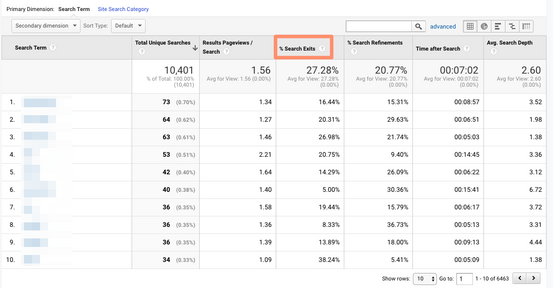There are a lot of website statistics to decipher, but Google Analytics has got your team covered. Building up a history of metrics will enable you to identify trends and opportunities, all while analyzing your site’s traffic to make consistent and effective changes.
Google Analytics for beginners
The Google Analytics dashboard is organized into four sections. Each section highlights different data sets and balances
- Audience – This section helps you explore who your customers are. Information such as demographics, location, retention, and device technology. Using these metrics, you can interpret the impact of your marketing efforts on various user segments.
- Behavior – The section follows the user’s path and explains what customers do on your website. Data offers users maps such as pages they visit and duration of stay on each page. These metrics can be examined to understand the overall user experience and its effects on retention and engagement.
- Acquisition – In the Channels section, you can dig into what channels (organic traffic, social media, email, ads, etc.) deliver the most traffic. This is how you figure out how users ended up on your site. You can compare incoming visitors from different social platforms, determine the efficiency of your SEO efforts on organic search traffic, and see how well your email campaigns are running.
- Conversions – Conversion analysis tracks whether customers end up converting or taking actions the way you presumed. This typically involves defining funnels of variables, such as purchases. This helps to see how well the site encourages these actions over time.

10 Google Analytics Website Metrics You Need to Analyze
- The ratio of new to returning visitors – When comparing the ratio of new users to returning users, you can determine how well your campaigns drive new or existing user traffic. Both metrics are important, especially as returning users can indicate an increase in lifetime value and brand loyalty. An increase in new users can indicate growth and potential.
If you notice your website is going strong on the sessions metric, you should need to accomplish that you have a loyal group of visitors. However, always strive to increase your discoverability! - Visitors Using Mobile Devices vs. Desktops – You can find this data in the Behavior section, under Events and Overview. Then scroll to the bottom where the events are located and select the name of your newsletter click event. At the bottom of this page, you can then select “Secondary dimension” to break the results down by other metrics:
By breaking down newsletter open events by device, for instance, you can determine whether the email campaign is getting better or worse click-through on mobile devices versus desktop and tablets.
Google has revealed that upwards of half of all searches done on it originate from mobile devices. - Sessions – Google Analytics defines sessions as “a group of user interactions with your website that takes place within a given time frame.” A session begins when a user arrives on your website and ends after 30 minutes of inactivity, at midnight, or if the user enters the site through one campaign, leaves, and comes back through another campaign.
Sessions are different from users because one user could trigger multiple sessions. They are helpful to track when analyzing changes to session count and sessions per source to evaluate how effective your campaigns are.
- Visitor Trends – If the visitors are coming to the site and then immediately leaving (this is called your site’s bounce rate), you may need to take a close look at the content on the page, update it, and then monitor results.
You can also track the number of page views, average page views per visit and average time spent on the websiteThis goes hand in hand with tracking when users exit your site and what page this happens on.
However, many factors in Google Analytics can determine user trends and help conduct user support.
- Source – The source metric in Google Analytics refers to where traffic to your website comes from such as a search engine, Google suggestion, or direct. Direct is when the user goes directly to the URL by manually typing it out.
The Channels metric in Google Analytics refers to the groups of traffic sources within the same medium such as Social, Organic Search, Direct, Email, and Paid Search.
As you continue to grow your marketing campaigns through social media and online mediums, analyzing source traffic is vital to understanding campaign performance and organic outcomes.
- Average time on page – Average time on a page is an indicator of engagement. A high average time on a page typically means a low bounce rate, which indicates customers are interested in your content and in exploring your website.
This metric indicated which content performs on your website, specifically for individual pages. - Keyword analysis – Analyzing keywords helps to determine which aspects lead users to your site. It also allows you to analyze which keywords can be utilized to boost performance.
These opportunities can be used in new blog posts, existing pages, or even social media campaigns. When using Google Analytics as your web analytics tool, you can also monitor your pay-per-click campaigns.
- Pages per session – Average pages per session is the number of pages a user views, on average, in a single session on your site.
This is a great indicator of user engagement. Apart from bounce rate, this metric determines how ambitious the user is with your website. Do they find all of the information on one page? If not, which other pages are they drawn to?
Keep in mind the average session duration as well to decipher if graphics or large text paragraphs are getting in the way.
- Exit pages – On the flip side of landing pages, you have the exit pages.
These are the pages from where visitors are terminating their journey on your website. Saying bon voyage!
The problem arises when almost all your landing pages double up as exit pages. Most likely, visitors are unable to find what they have expected.
For example, if you see in your that your Checkout page is one of the most exited pages on your site instead of the “Confirmed Order” page, then there may be an issue on your Checkout page that is preventing users from moving on in the user flow. - Bounce rate – Bounce rate is the percentage of users who visit only one page on a website before leaving. Typically indicating an error/technical problem, insufficient content, or ultimate a break in the website like internal links. Ultimately, something deterred them away…
If your bounce rate is high, you should segment your site visitors to see if you can determine the underlying issue.
Analyzing marketing and website data begins with determining which metrics are important to your business. Using the 10 metrics we listed above, you can begin to build a history of progressive data to determine what is fit for your brand. Time to become noticeable!
Looking to redesign your website? Contact Palnode today.




